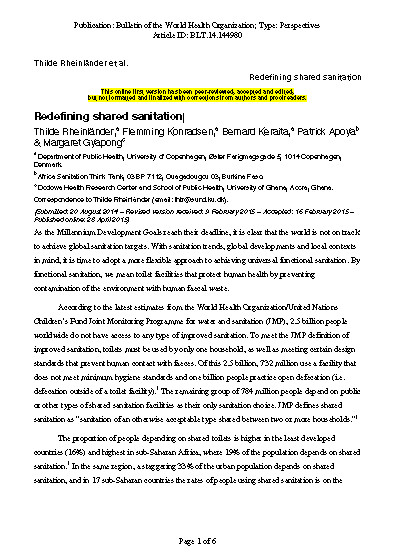Redefining shared sanitation
 |
article Apr 2015 ; 6 pages
Aut. Patrick Apoya & Margaret Gyapong &
Ed. WHO - Genève
Téléchargeable sous format: PdF
Téléchargeable chez l'éditeur
Abstract:
Current definitions do not account for the diversity of shared sanitation: all shared toilet facilities are by default classified as unimproved by JMP because of the tendency for shared toilets to be unmanaged and unhygienic. However, we argue that shared sanitation should not be automatically assumed to be unimproved. We also argue that it is necessary to have a new look at how we define shared sanitation and use specific sub-categories including household shared (sharing between a limited number of households who know each other), public toilets (intended for a transient population, but most often the main sanitation facility for poor neighbourhoods) and institutional toilets (workplaces, markets etc.).
This sub-classification will identify those depending on household shared sanitation, which we consider to be only a small step away from achieving access to private and improved sanitation. This sub-category of shared sanitation is, therefore, worth discussing in greater detail. Experiences from Ghana and other sub-Saharan African countries illustrate how household shared sanitation may well fit with culturally acceptable sanitation choices and not necessarily be unhygienic. Indeed, household shared sanitation may be the only realistic option that brings people the important first step up the sanitation ladder from open defecation to a basic level of sanitation.
Mots clefs: |
assainissement (CI) (DT) (OP) (ope) , bloc sanitaire public (CI) (DT) (OP) (ope) , toilettes, latrine (CI) (DT) (OP) (ope) |
Editeur/Diffuseur: |
|
WHO
-
World Health Organization - Genève - Suisse |
En cas de lien brisé, nous le mentionner à communication@pseau.org